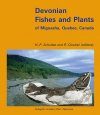![Devonian Fishes and Plants of Miguasha, Quebec, Canada Devonian Fishes and Plants of Miguasha, Quebec, Canada]()
Click to have a closer look
About this book
Customer reviews
Related titles
About this book
In 1842, the Canadian geologist Abraham Gesner discovered the first fossil fish in the cliffs of Miguasha, an area in eastern Quebec known as Scaumenac Bay which yielded one of the richest and most diverse Paleozoic biotas preserved in the Devonian Escuminac Formation. Especially the fishes and plants of this assemblage have been extensively collected and studied by many paleontologists from around the world. That started with the publications by the Canadian paleontologist J. F. Whiteaves in the 1880ies, continued by two famous British paleoichthyologists, A. S. Woodward and R. H. Traquair, at the end of the last century. During this century, Miguasha was visited frequently by American and European scientists so that the flow of publications continued. Private collecting by local families supplied the scientists with additional and new material. Since 1981, the cliffs of Miguasha have been a provincial park to assure protection of the site. Scientists from all over the world met for the 7th International Symposium on the Studies of Early Vertebrates at the interpretation center of the Parc de Miguasha in 1991.
Exceptional state of preservation, abundance and evolutionary significance of the fossils make Miguasha a world-class locality. Among the fossil fishes found in Miguasha, Eusthenopteron became the keystone for our understanding of one of the most important steps in vertebrate evolution, the conquest of land. E. Jarvik, Stockholm, made Eusthenopteron the best studied fossil fish to such details as the course of nerves and blood vessels. Also found at Miguasha is Elpistostege, which is even closer to tetrapods than Eusthenopteron.
The book provides a complete coverage of the Escuminac fossils and their paleoenvironment. A historian, a sedimentologist, a geochemist, a palynologist, paleobotanists, and paleozoologists from five countries contributed to reviving this 365 million years old ecosystem. Every species of plants, invertebrates, and fishes of the Escuminac Formation are described, abundantly illustrated, and placed in the tree of life.
Miguasha is a time-capsule that significantly enhances our understanding of the Late Devonian as a step in our own evolution.
Since December 1999, Miguasha Park was inscribed on the UNESCO World Heritage List. In its representation of vertebrate life, Miguasha is the most outstanding fossil site in the world for illustrating the Devonian as the ""Age of Fishes"". The area is of paramount importance in having the greatest number and best preserved fossil specimens found anywhere in the world of the lobe-finned fishes that gave rise to the first four-legged, air-breathing terrestrial vertebrates - the tetrapodes.
Customer Reviews























![Pravěký Svět Zdeňka Buriana, Kniha 2: Monstra Třetihor a Čtvrtohor [The Prehistoric World of Zdeněk Burian, Volume 2: Tertiary and Quaternary Monsters]](http://mediacdn.nhbs.com/jackets/jackets_resizer_medium/26/263198.jpg?height=150&width=108)




![Palaeo Ichthyologica, Volume 14 [English]](http://mediacdn.nhbs.com/jackets/jackets_resizer_medium/22/229043.jpg?height=150&width=106)






